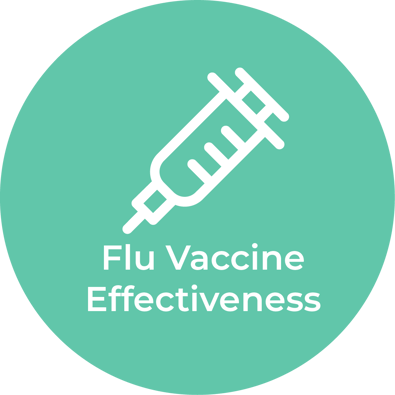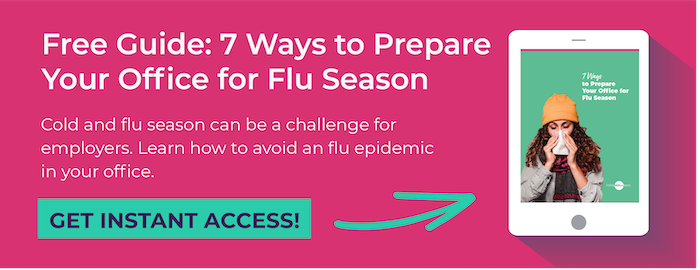 Flu season is coming in fast.
Flu season is coming in fast.
Not surprisingly, flu season is expensive for businesses, as it results in lost productivity and a spike in healthcare claims.
Annually, the flu costs U.S. businesses around $10.4 billion in direct costs for hospitalizations and outpatient visits for adults.
Luckily, one little shot can help with that. Vaccination against the flu may reduce risk of getting ill by 40 to 60 percent.
But getting it on time and before flu symptoms arrive in the body is key. Peak flu season is from December to February, but it can run from October to May.
And with a recent delay in some shipments of flu vaccines, it’s especially important for employees to get their flu shot as soon as it’s available. The delay shouldn’t cause shortages of the vaccine, and we have already received our vaccine here at TotalWellness.
So, just how effective is the flu shot? We share all the details below.
How Dangerous is the Flu?
Around 8% of the U.S. population gets ill each flu season, which starts in the fall and winter months.
The Centers for Disease Control and Prevention (CDC) estimates that mild flu seasons kill approximately 12,000 Americans and up to 56,000 in a severe season.
The 2017-18 season was particularly bad, with 80,000 deaths due to flu and its complications, the worst season since 2009. It was the first flu season in over a decade in which all states in the U.S. reported flu cases.
The 2018-2019 Flu Season
From October 1, 2018, to May 4, 2019, the CDC documented between 17.3 to 20.1 million flu medical visits.
Although it was the longest season in 10 years, preliminary statistics for the 2018-2019 flu season showed fewer hospitalizations than any other season since the CDC began monitoring. This may be related to a higher vaccination rate and a better-matched virus strain.
Estimates from the CDC show the 2018-19 flu shot reduced the risk of infection by around 46% in adults and 62% in children.
Who is Most at Risk for the Flu?
The CDC recommends flu shots for everyone over 6 months old. The first time they are vaccinated, children under 8 should get two flu shots about a month apart.
Who is most at risk:
- Children under 5
- Pregnant women
- Elderly (65+)
- Individuals with compromised immunity
A Special Note on Hand Washing
Local county fair season will occur over the next month or so across the nation. This unique setting offers the public a chance to interact with farm animals they might not normally encounter. The 2009 flu pandemic actually originated in pigs and caused more than 12,000 deaths in the U.S.
If you and your family plan to attend a fair where there’s access to a petting zoo with pigs, be sure to wash your hands frequently and use sanitizer after contact with animals, especially pigs.
In general, it’s best to wash your hands for at least 30 seconds with warm, soapy water. Sing “Happy Birthday” twice to make sure you’ve washed away all germs.
What’s in a Flu Shot?
There are three types of flu viruses that affect humans: A, B, and C. The ones that cause epidemics? A and B strains. The C strain is not associated with epidemics. Flu shots contain strings of types A and B inactivated influenza viruses or particles that are designed to look like viruses to spur the immune system into action.
How Effective is the Flu Shot?
Every year, doctors and healthcare providers hear the same question: “How effective is the flu shot?” If you’re asking the general public, it really depends on who you ask. Some people will claim the flu shot never works for them. Others swear by it.
Here’s what one report showed: A 2017 study found that flu vaccination reduced intensive care unit (ICU) admissions, ICU length of stay, and overall hospitalization length among flu patients. It also reduced the amount of flu-related deaths.
In General
It truly depends, as flu strains vary each year. Because flu shots are prepared about a year in advance, it is tough to predict what strains will be active during flu season. The flu shot works best when the active strains match the vaccine.
CDC studies show that the strains have been well-matched over the years. The flu vaccine can reduce the risk of the flu from 40% to 60% or prevent millions of illnesses. When someone contracts the flu after being vaccinated, their symptoms are typically milder and less dangerous.
For High-Risk Populations
High-risk populations include the elderly and those with compromised immune systems. The flu can quickly weaken immunity and cause additional health issues.
Some examples:
- The flu virus has been linked to heart attacks in people with heart disease. The vaccination has been shown to reduce the number of cardiac events associated with flu complications.
- Diabetics and people with chronic lung disease are more likely to suffer from flu complications that require hospitalization. Vaccinations have been shown to reduce the need for hospital stays in these populations.
Pregnant Women and Children
Studies have shown that women vaccinated while pregnant reduce their chance of a flu-related hospital stay by 40%. By receiving the flu vaccination, they may also pass the vaccination benefits onto their unborn child.
A study that reviewed flu seasons from 2010 to 2014 found that the risk of childhood death due to the flu and complications was reduced by 51-65% by vaccination.
Keep Your Office Safe During Flu Season
Although it varies from year to year, the flu shot can be very effective in reducing cases of the flu and serious complications.
Help keep your office and community healthy by organizing a flu shot clinic before the end of November, if possible. Doing so can reduce the number of visits your employees make to health providers by 44% through the duration of the flu season.
Another tip for flu season safety is to keep lots of hand sanitizer and tissues around to minimize the passing of germs.
If you can tell someone is clearly sick, ask them to go home. This will help them return to work faster and will protect the rest of your employees.
Want to get ahead of the flu this season? Learn more about how to protect your office during flu season with our free guide: Prepare Your Office for Flu Season!



